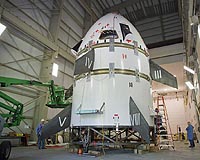 |
Cape Canaveral, Florida (AFP) July 12, 2009 US ambitions to send astronauts back to the moon, as a prelude to future Mars missions, have been put in doubt by budgetary constraints, 40 years after man's triumphant first lunar landing. After the Columbia space shuttle disaster in 2003, former president George W. Bush decided to phase out shuttle flights by 2010 and set a more ambitious space mandate for America. Launched in 2004, the so-called Constellation program aims to take Americans back to the moon by 2020 and to use it as a launch pad for manned voyages to Mars. Without renouncing those objectives, President Barack Obama has named a commission of experts to review the US manned space flight program and make recommendations by the end of August. The space shuttles, which have carried crews of astronauts into space since 1981, were conceived as reusable vehicles to transport heavy, bulky equipment into Earth's orbit, primarily for the construction of the International Space Station (ISS). But the shuttle has kept the United States stuck in a low orbit for too long at a time when other countries like China are emerging as rivals in space, argues Michael Griffin, the former NASA chief who championed the Constellation program. "I think we must return to the moon because it's the next step. It's a few days from home," he said. "Mars is only a few months from Earth." In unveiling the Constellation program in 2004 to Congress, Griffin said: "The single overarching goal of human space flight is the human settlement of the solar system, and eventually beyond." "In the long run, human populations must diversify if (man) wishes to survive," he said in an interview with AFP last year. But NASA's budget is not big enough to cover the cost of Constellation's Orion capsule, a more advanced and spacious version of the Apollo lunar module, and the Ares I and Ares V launchers needed to put it in orbit. Constellation is projected to cost about 150 billion dollars, but estimates for the Ares I have skyrocketed from 26 billion dollars in 2006 to 44 billion dollars last year. With a space exploration budget of six billion dollars in 2009, Senator Bill Nelson of Florida said: "NASA simply can't do the job it's been given -- the (former) president's goal of being on the moon by 2020." Nelson, a former astronaut, said that after 2010, when the shuttle program ends, the United States will have no way of transporting its astronauts to the ISS except aboard Russian Soyuz space craft. Astronaut Harrison Schmitt, part of the last Apollo mission to the moon in 1972, told AFP that the Constellation was conceptually "excellent" but had been underfunded. "The underfunding is massive. It's not the program that is wrong, it's the way that has been funded," he said. Meanwhile, a group of active and retired NASA engineers who are critical of the Constellation project, have been working in their spare time on a parallel project dubbed DIRECT Jupiter. It envisions using the Orion capsule but replacing the Ares launchers with a family of launchers with common components based on existing shuttle technology. The group has presented proposals to Obama's commission on human space flight saying their project would cost less to develop and get astronauts back to the moon more quickly. The commission chairman, respected former Lockheed Martin chief executive Norman Augustine, said it comes down to money. "With a few exceptions, we have the technology or the knowledge that we could go to Mars if we wanted with humans. We could put a telescope on the moon if we wanted," he said. "The technology is by and large there. It boils down to what can we afford?" Share This Article With Planet Earth
Related Links Space Tourism, Space Transport and Space Exploration News
 Astronaut Safety Gets Max Attention
Astronaut Safety Gets Max AttentionWallops Island VA (SPX) Jul 09, 2009 NASA's next generation of spacecraft will have the safest-ever astronaut escape system, a modern-day version of the reliable Apollo system. Like Apollo, the Orion launch abort system will swiftly propel the crew capsule away from the nose of the Ares I rocket and out of harm's way in case of an emergency on the launch pad or during ascent to orbit. Also - as was the practice at times ... read more |
|
| The content herein, unless otherwise known to be public domain, are Copyright 1995-2009 - SpaceDaily. AFP and UPI Wire Stories are copyright Agence France-Presse and United Press International. ESA Portal Reports are copyright European Space Agency. All NASA sourced material is public domain. Additional copyrights may apply in whole or part to other bona fide parties. Advertising does not imply endorsement,agreement or approval of any opinions, statements or information provided by SpaceDaily on any Web page published or hosted by SpaceDaily. Privacy Statement |